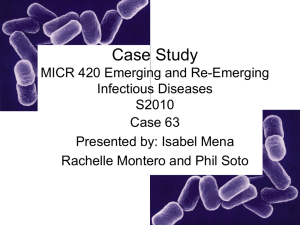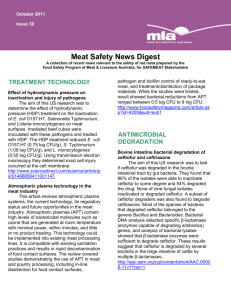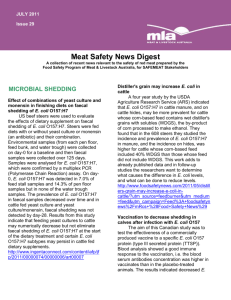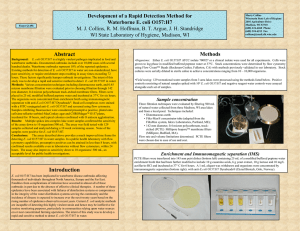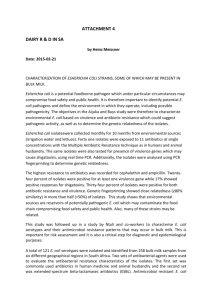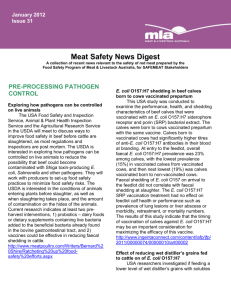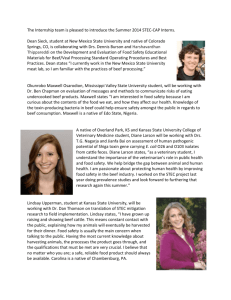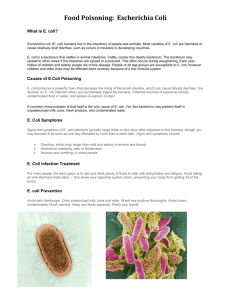Feb 2013 - Food Safety Centre
advertisement
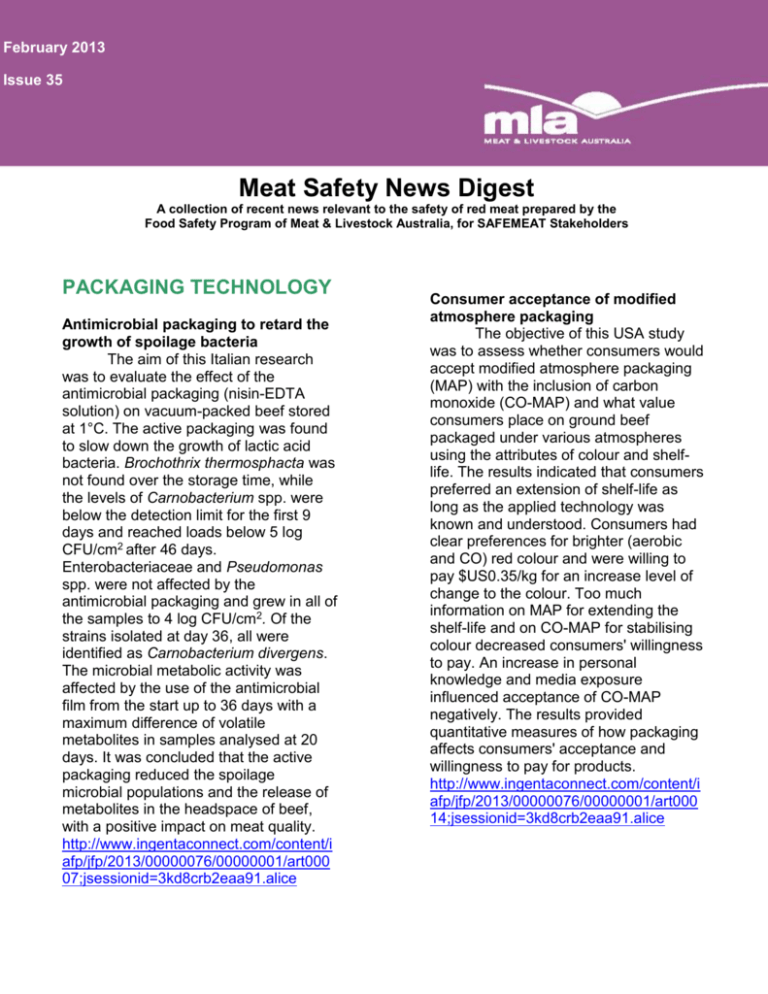
February 2013 Issue 35 Meat Safety News Digest A collection of recent news relevant to the safety of red meat prepared by the Food Safety Program of Meat & Livestock Australia, for SAFEMEAT Stakeholders PACKAGING TECHNOLOGY Antimicrobial packaging to retard the growth of spoilage bacteria The aim of this Italian research was to evaluate the effect of the antimicrobial packaging (nisin-EDTA solution) on vacuum-packed beef stored at 1°C. The active packaging was found to slow down the growth of lactic acid bacteria. Brochothrix thermosphacta was not found over the storage time, while the levels of Carnobacterium spp. were below the detection limit for the first 9 days and reached loads below 5 log CFU/cm2 after 46 days. Enterobacteriaceae and Pseudomonas spp. were not affected by the antimicrobial packaging and grew in all of the samples to 4 log CFU/cm2. Of the strains isolated at day 36, all were identified as Carnobacterium divergens. The microbial metabolic activity was affected by the use of the antimicrobial film from the start up to 36 days with a maximum difference of volatile metabolites in samples analysed at 20 days. It was concluded that the active packaging reduced the spoilage microbial populations and the release of metabolites in the headspace of beef, with a positive impact on meat quality. http://www.ingentaconnect.com/content/i afp/jfp/2013/00000076/00000001/art000 07;jsessionid=3kd8crb2eaa91.alice Consumer acceptance of modified atmosphere packaging The objective of this USA study was to assess whether consumers would accept modified atmosphere packaging (MAP) with the inclusion of carbon monoxide (CO-MAP) and what value consumers place on ground beef packaged under various atmospheres using the attributes of colour and shelflife. The results indicated that consumers preferred an extension of shelf-life as long as the applied technology was known and understood. Consumers had clear preferences for brighter (aerobic and CO) red colour and were willing to pay $US0.35/kg for an increase level of change to the colour. Too much information on MAP for extending the shelf-life and on CO-MAP for stabilising colour decreased consumers' willingness to pay. An increase in personal knowledge and media exposure influenced acceptance of CO-MAP negatively. The results provided quantitative measures of how packaging affects consumers' acceptance and willingness to pay for products. http://www.ingentaconnect.com/content/i afp/jfp/2013/00000076/00000001/art000 14;jsessionid=3kd8crb2eaa91.alice SOURCES OF CONTAMINATION Transfer of veratoxigenic E. coli during sheep slaughter The purpose of this UK study was to investigate carriage and transfer of veratoxigenic E. coli (VTEC) O157, O26, O111, O103 and O145 from fleece to dressed carcasses. Sheep (n = 500) were sampled (10 g of fleece, plus a full carcass swab) through the slaughter process. Samples were examined for the presence of verotoxin (vt1 and vt2) genes using a PCR assay and positive samples were further screened for the presence of the chosen five serogroups by real-time PCR. VTEC O26 was recovered from 5/500 (1.0%) fleece and 2/500 (0.4%) carcass samples. VTEC O157 was isolated from 4/500 (0.8%) fleece samples and 3/500 (0.6%) carcass samples. E. coli O103 was recovered from 84/500 (16.8%) fleece and 68/500 (13.6%) carcasses. O145 was recovered from one fleece sample, but it did not carry vt genes. O111 was not detected in any samples. For the four serogroups recovered, the direct transfer from fleece to carcass was not observed, showing that VTEC O26 isolates from a matched fleece/carcass “pair” were not identical. This study shows that while VTEC O157 are being carried by sheep presented for slaughter in Ireland, other potentially clinically significant verotoxin producing strains (particularly VTEC O26) were present. http://www.sciencedirect.com/science/arti cle/pii/S0740002012002584 Sources of E. coli deposited on beef during breaking of carcasses Canadian researchers obtained microbiological samples from the hands of workers, personal equipment and conveyor belts in the carcass breaking facility of a beef packing plant to determine sources of contamination. Before work started, steel mesh gloves carried coliform and E. coli counts of 4 and 3 log cfu/25 gloves, respectively, while counts on conveyor belts were >2 and <2 log cfu/2500 cm2, respectively. After a work shift, the numbers of both coliforms and E. coli on steel mesh gloves and conveyor belts were reduced by about 1 log unit. The findings indicated that the proximate source of most coliforms and E. coli that contaminate cuts and trimmings were, in order, cotton gloves and conveyors. In a second study using rubber gloves placed over cotton ones prevented contamination from cotton gloves. The conveyor belt carried coliforms and E. coli at numbers about 1 cfu/cm2 and >1 cfu/100 cm2, respectively, before work started; and at numbers < 1 cfu/cm2 and about 1 cfu/100 cm2, respectively, after the period of work to process a lot of carcasses. The findings in this study indicated that both cuts and trimmings are contaminated with coliforms and E. coli primarily from the conveyor. http://www.sciencedirect.com/science/arti cle/pii/S0956713512005452 E.COLI O157 SHEDDING Effects of between- and within-host variability on E. coli O157 shedding The variability in the E. coli O157 shedding level between animals (between-host variability), as well as fluctuations in the level shed by a single animal (within-host variability), is difficult to interpret. Hence, to explain the relative contribution of between- and within-host variability to shedding patterns, USA researchers developed a model. The model integrates individual animal data on faecal shedding over time, with penlevel E. coli O157 transmission to determine how the temporal (and aggregation) patterns of E. coli O157 shedding loads and prevalence arise. They found that even without betweenhost variability, the prevalence of animals with concentrations of E. coli O157 in faeces that exceeded 104 CFU/g was similar to that observed in other field data. They also found both within-host and between-host variability can result in super-shedders. http://www.sciencedirect.com/science/arti cle/pii/S0167587712003030 Diversity of E. coli O157:H7 isolates from super-shedders and lowshedders This Canadian study investigated relationships among faecal and perineal hide (PS) isolates from super-shedders and low-shedder pen-mates using pulsed-field gel electrophoresis (PFGE), and DNA fingerprinting technique. Samples were taken at entry to the feedlot (sampling 1) and prior to slaughter (sampling 2). One steer maintained super-shedder status at both samplings, and approximately 30% of super-shedders in sampling 1 had lowshedder status at sampling 2. Genetic similarity among the isolates was not associated with shedding status (superor low-shedder). Only 2/21 supershedders had faecal isolates in the same genetic group at both samplings. Faecal and PS isolates from individual supershedders generally belonged to different genetic groups, although faecal isolates of E. coli O157:H7 from super- and lowshedders showed greater similarity than those from PS. For 77% of supershedders, DNA profiles of faecal and PS isolates were distinct from low-shedder faecal isolates collected in the same pen. A low level of antimicrobial resistance (3.7%) was detected, and prevalence of antimicrobial resistance did not differ among super- and low-shedder isolates. The results demonstrated that DNA and genetic profiles of E. coli O157:H7 from individual super-shedders varied over time and that only 1/162 steers remained a super-shedder at both samplings. Subtypes of E. coli O157:H7 from faecal isolates of super- and low-shedders were different as were subtypes of faecal and PS isolates from super-shedders. http://www.biomedcentral.com/17466148/8/178/abstract SPOILAGE RESEARCH Effect of respiration on spoilage caused by Leuconostoc gasicomitatum In this Finnish study, they investigated meat respiration effects on Leuconostoc gasicomitatum growth rate, biomass, gene expression and volatile organic compounds (VOC) production. They observed that functional respiration increased the growth (rate and yield) of L. gasicomitatum in laboratory media with added heme (ferrous molecule in blood), and in situ meat with endogenous heme added. Respiration increased the accumulation of acetoin and diacetyl (x2600) which are buttery off-odour compounds in meat. Gene analyses showed that the gene expression patterns were similar regardless of whether respiration was stopped experimentally. They concluded respiration is a key factor in explaining why L. gasicomitatum is so well adapted in high-oxygen packed meat. http://aem.asm.org/content/early/2012/11 /28/AEM.02943-12.short?rss=1 Compounds associated with microorganisms in blown pack spoilage This Brazilian study correlated the composition of the spoilage bacterial flora with the main gaseous and volatile organic compounds (VOCs) found in spoiled, chilled, vacuum-packed beef. More than 50% of the bacteria were identified as lactic acid bacteria (LAB), followed by clostridia and enterobacteria. The major spoilage compounds were identified as alcohols and aldehydes. CO2 was identified as the major gas in the spoiled samples. Hence, different species of lactic acid bacteria contributed to the production of major volatile compounds during meat spoilage. http://onlinelibrary.wiley.com/doi/10.1111 /lam.12004/abstract Air-liquid interface biofilm formation by pseudomonads In this European paper, they assessed the ability of Pseudomonas bacteria, isolated from vacuum-packed meat, to colonise the surface of liquids, as well as biofilm formation at the meniscus and air–liquid (A–L) interface. Sixty isolates were recovered from vacuum-packed venison, of these, 12% were found to produce biofilms limited to the meniscus region of the microcosm walls. 31% produced attached biofilms with extensions across the A–L interface, and 45% produced unattached ‘floating’ biofilms. Statistical analysis of growth, biofilm strength and attachment levels showed that growth affected strength but not attachment, and that there was a significant relationship between attachment and strength. This survey suggested that biofilm formation may be more common in psychrotrophic meatassociated isolates than amongst the wider pseudomonad community from which spoilage bacteria might be found. Aggregations of bacteria may be more resistant to competition and dehydration stress than individual bacteria. http://www.springerlink.com/content/v00q 0701k1454198/ Reduction of spoilage of chilled vacuum-packed lamb New Zealand researchers investigated methods to reduce lamb spoilage caused by psychrotolerant Clostridium species, including exposure to air, hot and cold water spray washing, and tyndallisation (i.e. heating products to high temperatures for short time periods over three days to germinate bacterial spores and kill the resulting vegetative cells). Initially vegetative cells of psychrotolerant clostridia associated with spoilage of chilled vacuum-packed meat were exposed to aerobic cooked meat medium at room temperature (21°C) to determine how long they remained viable. Survival of strains varied from 2 hours to 3 days. Vegetative cells of Clostridium estertheticum subsp. estertheticum survived 7 days at 10°C with little reduction in viable numbers. Hence, exposure to air was ruled-out as a method of spoilage reduction. Trials were also carried out on chilled vacuumpacked lamb inoculated with spores of C. estertheticum subsp. estertheticum. The time until inoculated packs reached the loss of vacuum, varied from 38 to 53 days. Hot and cold water washing extended the shelf life by 12 and 13 days respectively in comparison to untreated packs. http://www.sciencedirect.com/science/arti cle/pii/S0309174012003282 AERIAL MICROBIAL SURVEYS Detection of E. coli O157:H7 and Salmonella enterica in air and droplets To determine if airborne E. coli O157:H7 and Salmonella enterica were present in beef processing plants, US researchers placed sedimentation sponges at various locations in beef plants that processed cattle from slaughter through fabrication. In the slaughter area, of the 291 samples, E. coli O157:H7 was isolated from 15.8% and S. enterica from 16.5% of samples. In the evisceration area, of the 113 samples, E. coli O157:H7 was isolated from only one sample, and S. enterica was not isolated. Pathogens were not isolated from any of the 87 air samples from fabrication areas. Pathogen prevalence, aerobic plate counts, and Enterobacteriaceae counts were highest for samples obtained from locations near hide removal operations. Further sampling was undertaken in this area to compare hide removal locations that were close enough to be contacted by droplets and from locations that were not contacted by droplets. Higher pathogen prevalence, aerobic plate counts, and Enterobacteriaceae counts were observed at locations with samples contacted by the hide-removal droplets. Hence, they concluded that the hide removal processes may introduce pathogens into the air via a dispersion of liquid droplets. http://www.ingentaconnect.com/content/i afp/jfp/2012/00000075/00000012/art000 15;jsessionid=32wajngr4f8md.alexandra Comparison of aerial counts at different sites in abattoirs This UK study examined and compared levels of aerial contamination in commercial beef and sheep plants at four locations: lairage, hide/fleece pulling, evisceration and chilling. The levels of aerial contamination were similar at equivalent sites in beef and sheep plants, irrespective of the sampling method or the type of organisms recovered. Mean log counts for TVC, coliforms and Enterobacteriaceae in the chillers were generally lower than the corresponding mean log numbers recovered at the other three sites. Further studies in an experimental plant compared counts recovered from the neck of beef carcasses with air-suspended counts, determined with agar and irradiated meat pieces. No correlation was found between counts on beef carcasses and in the air, irrespective of the method used to compare counts. http://www.sciencedirect.com/science/arti cle/pii/S0740002012001542 TREATMENTS FOR MICROBIAL CONTROL Quercetin dietary supplementation may reduce microbial growth The aim of this Spanish study was to examine the effects of flavonoids on meat quality attributes. Thirty-two Merino lambs fed straw and a concentrated formula either containing palm oil (CTRL) plus quercetin (QCT) or flaxseed (FS) plus quercetin (FS-QCT), were used. Cuts were stored at 4°C and sampled at 0, 3 and 7 days. Chemical composition of longissimus thoracis (LT) muscle was not different among treatments. The longissimus lumborum (LL) samples of QCT and FS-QCT groups revealed lower discolouration when compared to the CTRL and FS lambs, whereas extract release volume and microbiological data suggested that flaxseed and quercetin (FS-QCT) may reduce the growth of microbial populations responsible for meat spoilage in quadriceps femoris (QF). http://www.sciencedirect.com/science/arti cle/pii/S0309174012003026 Evaluation of carvacrol for the control of E. coli O157 Irish researchers assessed the antimicrobial activity of carvacrol (an essential oil of oregano) against E. coli O157 on cattle hide and carcass cuts. Carvacrol (0, 10, 20, and 30 mg/mL) was applied to cattle hide and beef carcass cuts that had been inoculated with a cocktail of E. coli O157 (5–6 log10 CFU/cm2) and left in contact for 10 min. Carvacrol at 30 mg/mL reduced inoculated E. coli O157 on hide and cuts 1.4 and 1.58 log10 CFU/cm2, respectively, compared to the no-wash and water-wash controls. This preliminary study shows that carvacrol has the potential to control E. coli O157 on bovine hide and carcass cuts, but further research with larger scale trials is needed. http://online.liebertpub.com/doi/abs/10.10 89/fpd.2012.1224 Sensitivity of nSTEC and Salmonella to lactic acid on trimmings The aim of this US study was to determine whether lactic acid treatments used to reduce E. coli O157:H7 on beef trimmings were also effective in controlling non-O157 Shiga toxinproducing E. coli (nSTEC), and Salmonella. Beef trimmings pieces were inoculated (3 log CFU/cm2) with E. coli O157:H7, O26, O45, O103, O111, O121, and O145, with each serotype mixture made-up of 4 strains. A second set of trimmings were separately inoculated with E. coli O157:H7, Salmonella Newport and Salmonella Typhimurium. The inoculated trimmings were left untreated (control) or were immersed for 30 seconds in 5% lactic acid solutions (25 or 55°C). Both E. coli O157:H7 and nSTEC were reduced by 0.5 to 0.9 (25°C lactic acid) and 1.0 to 1.4 (55°C lactic acid) log CFU/cm2. Counts of Salmonella on treated trimmings were not influenced by serotype or antibiotic resistance phenotype and were similar or lower than counts of E. coli O157:H7. The results indicated that lactic acid treatments used against E. coli O157:H7 on beef trimmings should be similarly or more effective against the six nSTEC serogroups and Salmonella Newport and Salmonella Typhimurium. http://www.ingentaconnect.com/content/i afp/jfp/2012/00000075/00000010/art000 04;jsessionid=25yc8y2gptxx7.victoria VACCINATION MODEL A model to evaluate risks and benefits of E. coli vaccination in cattle US researchers developed a stochastic simulation model to evaluate the impact of E. coli O157:H7 vaccination on key epidemiological outcomes. The model evaluated a reduction in the O157 prevalence in feedlot cattle as well as concentration in cattle faeces due to vaccination. The results showed that vaccination can have a significant benefit such as reduction in (1) the number of human O157 illnesses due to the consumption of ground beef, (2) the number of production lots with high O157 contamination levels, (3) the likelihood of detection by USDA Food Safety and Inspection Service testing, and (4) the probability of multiple illnesses due to ground beef servings from the same lot. These results showed that these outcomes are most strongly impacted by pre-harvest vaccination. http://online.liebertpub.com/doi/abs/10.10 89/fpd.2012.1150 (EFSA). Consumer groups said if chemicals such as lactic acid were allowed, their use should be made transparent for consumers. Shoppers should be able to rely on clear labels telling them whether or not their meat has been chemically treated. France, Greece, Latvia, Austria and Poland voted against the decision. http://www.themeatsite.com/meatnews/1 9616/eu-gives-goahead-to-lactic-acid-inmeat-processing REGULATORY NEWS EU Parliament approves use of lactic acid European Union ministers gave approval for the use of lactic acid as a decontaminant in beef processing. The process has been described as safe by the European Food Safety Authority © Meat & Livestock Australia ABN: 39 081 678 364 Care is taken to ensure the accuracy of information in the publication. However, MLA cannot accept responsibility for the accuracy and completeness of the information or opinions contained in the publication. Readers should rely on their own enquiries in making decisions concerning their interests. Reproduction in whole or in part of this publication is prohibited without the prior written consent of MLA. Produced by the Food Safety Centre for Meat & Livestock Australia FOR FURTHER INFORMATION PLEASE CONTACT: Manager, Market Access Science and Technology Ian Jenson PH: 02 9463 9264 ijenson@mla.com.au MEAT AND LIVESTOCK AUSTRALIA, LOCKED BAG 991 NORTH SYDNEY NSW 2059
